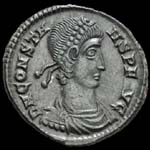
To reduce the monetary disorder at the time of Augustus, he launched a substantial reform in the Republican Roman coinage.
One of the most important innovation was the assignment to the senate of the control of the coinage in copper and in orichalcum (a brass alloy with a league to the 80% of copper and the 20% of zinc), pointed out by the initials "SC" (Senatus Consulto) present in these coins, maintaining the direct control of the emperor for the coins in gold and silver.
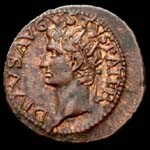
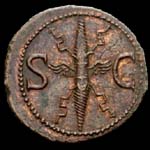
The new monetary system introduced by Augustus is represented in the following table:
| Metal | Coin | Ratio with the as |
Ratio with the denarius |
Ratio with the libra |
Weight |
|---|---|---|---|---|---|
| Gold | Denarius aureus | 400 | 25 | 1/42 | 7,78g |
| Quinarius aureus |
200 |
12,5 |
1/84 | 3,89g | |
| Silver | Denarius argenteus | 16 | 1 | 1/84 | 3,89g |
| Quinarius argenteus | 8 | 1/2 | 1/168 | 1,94g | |
| Orichalcum | Sestertius | 4 | 1/12 | 27,28g | |
| Dupondius | 2 | 1/24 | 13,64g | ||
| Copper | As | 1 | 1/30 | 10,90 g | |
| Quadrans | 1/4 | 1/192 | 1,70g |
The images and the inscriptions changed in comparison to the republican period: the obverse introduces the emperor with his title, while the reverse refers to its activity or virtues.
The strong devaluation present in the empire forced a reform to reduce the value of the gold and silver coins. The weight of the golden coins was reduced, while a copper percentage was introduced in the coinage of the denarius, no more coined in pure silver. The resulting system is depicted the following table:
| Metal | Coin | Ratio with the libra |
Weight |
|---|---|---|---|
| Gold | Denarius aureus | 1/45 | 7,27g |
| Quinarius aureus | 1/90 | 3,64g | |
| Silver | Denarius argenteus | 1/96 | 3,41g |
| Quinarius argenteus | 1/192 | 1,70g | |
| Orichalcum | Sestertius | 1/12 | 27,28g |
| Dupondius | 1/24 | 13,64g | |
| Copper | As | 1/30 | 10,90 g |
| Quadrans | 1/192 | 1,70g |
As coin of lower value, the semis was introduced, abandoned very soon, and for the dupondius the image of the head of the emperor with a radiant crown was introduced (what it recalled the rays of the sun) to the place of the classical crown of laurel; this image introduced the name of radiatus for the coin.
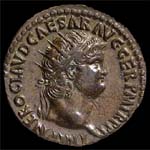
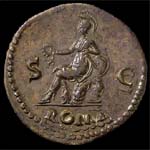
The persisting inflation due to the military expenses brought Caracalla in 215 to a new reform, with a ratio among the elements of the new monetary system as shown in the following table:
| Metal | Coin | Ratio with the libra |
Weight |
|---|---|---|---|
| Gold | Binione | 1/25 | 13,08g |
| Denarius aureus | 1/50 | 6,50g | |
| Quinarius aureus | 1/90 | 3,64g | |
| Silver | Antoninianus | 1/64 | 5,11g |
| Denarius argenteus | 1/96 | 3,41g | |
| Quinarius argenteus | 1/192 | 1,70g | |
| Orichalcum | Sestertius | 1/12 | 27,28g |
| Dupondius | 1/24 | 13,64g | |
| Copper | As | 1/30 | 10,90 g |
The most important innovation was the introduction of a new silver coin called antoninianus, that was worth 2 denarius. From the point of view of the images, the antoninianus used on the obverse the head of the emperor with a radiant crown.

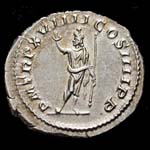
Other new coin introduced by Caracalla was the "double aureus", also know as binione.
The situation of the coins minted in the provinces of the Roman empire became more and more confused, so that in 240 the bronze coins were withdrawn by the Roman government to be melted.
In 270 AD emperor Aurelian is proclaimed, and in 274 AD he launched a reform of the monetary system and the organization of the mints, situated in the whole territory of the empire, with the goal to improve the control of the coin circulation. With the territorial reorganization, he increased the number of the mints and imposed the indication of the value and of the mint of origin on the coin to control the coinage production.
As far as the antoninianus, it had a weight of of 5,1g and the bronze percentage defined for the denarius equal to a ratio silver:copper of 1:20; this value is marked on the reverse of some coins with the Roman number XX.I in the western regions and with the Greek symbols K A in the eastern countries. This coin, at that time called aurelianeo or silvered antoninianus, for the techniques used to leave the aspect of a silver coin on surface, continued to be produced up to the monetary reform of Diocletian.
Also Diocletian as Aurelian, tried to reform the economic system of the empire.
A very important economic reform was the edict of the prices emanated by Diocletian in 301 AD, establishing the maximum price for goods like:
where
Intervening on the monetary system, this was organized electing the denarius as base coin, as shown in the following table:
| Metal | Coin | Ratio with the denarius |
Ratio with the libra |
Weight |
|---|---|---|---|---|
| Gold | Aureus | 625 | 1/84 | 3,89g |
| Silver | Argenteus | 25 | 1/168 | 1,94g |
| Silver-plated | Follis | 8 | 1/21 | 15,58g |
| Half follis | 4 | 1/42 | 7,79g | |
| Bronze | Antoninianus | 2 | 1/84 | 3,89 g |
| Denarius | 1 | 1/168 | 1,64g |
As far as the bronze coins hammered with silver foils on the surface, they were produced with alloys using 5% silver and 95% bronze.
Two new coins were coined: the follis in silvered bronze


and the argenteus in substitution of the antoninianus.
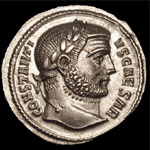
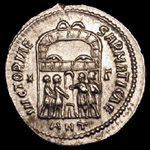
At the beginnings of the III century, the emperor Costantine reorganized the monetary system to give greater importance to gold coins, like the solid that was used in Rome up to the V century with a huge diffusion in the Byzantine Empire.
The new new system was defined according the following values:
| Metal | Coin | Ratio with the solidus | Ratio with the libra | Weight |
|---|---|---|---|---|
| Gold | Solidus | 1 | 1/72 | 4,54g |
| Semis | 1/2 | |||
| Triens | 1/3 | |||
| Silver | Miliarense | 1/18 | 1/71 | 4,54g |
| Siliqua | 1/24 | 1/96 | 3,41g | |
| Bronze | Follis | 1/96 (fino al 330) 1/192 (dopo il 335) |
3,41g 1,70g |
|
| Nummus |
where new coins in silver were introduced, like the siliqua
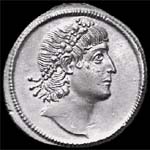
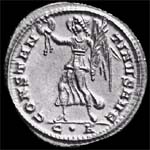
and of his double, the miliarense
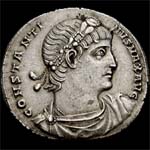
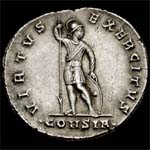
To follow the progressive reduction in value of the coins in copper, the pecunia maiorina was introduced, with a value double compared the one of the nummo centenionale and equal to 1/50 the one of the siliqua.
The new system adopted the following values:
| Metal | Coin | Ratio with the solidus | Diameter | Weight |
|---|---|---|---|---|
| Gold | Solidus | 1 | 4,54g | |
| Silver | Miliarense | 1/12 | 4,54g | |
| Siliqua | 1/24 | 3,41g | ||
| Bronze | Pecunia maiorina | 21-24mm | 5,45g | |
| Nummus centenionalis | 17-20 mm | 2,7g |
